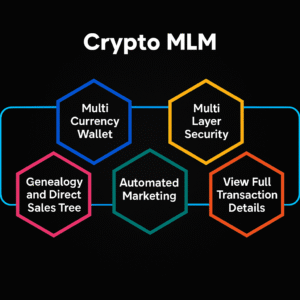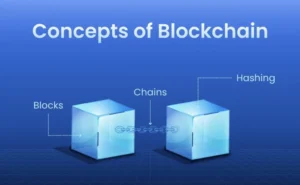
The Bitcoin blockchain is a revolutionary technological achievement that has transformed the world of finance and beyond. At the core of Bitcoin’s operation lies the process of adding new blocks to its blockchain. This process is crucial for maintaining the integrity and security of the Bitcoin network. This blog post delves into the intricacies of how a new block is added to the Bitcoin blockchain, focusing on essential concepts like blockchain blocks, block data, Bitcoin mining, and Bitcoin transactions.
What Exactly is a Bitcoin Block?
A Bitcoin block is a fundamental unit within the Bitcoin blockchain that serves as a container for a collection of transactions. Each block includes several key elements: the block header, which contains metadata such as the block version, the hash of the previous block, a timestamp, and a nonce; and the block body, which houses the list of transactions. The header’s hash ties the block to its predecessor, ensuring continuity and immutability of the blockchain. The block data, encompassing the transaction details and Merkle root, helps in maintaining the consistency and integrity of the Bitcoin network. By encapsulating transactions and linking to previous blocks, a Bitcoin block plays a crucial role in validating and securing the blockchain, thus upholding the decentralized and transparent nature of Bitcoin.
How does a Block Function in the Blockchain Network?
In Advanced Blockchain Development, a block functions as a digital ledger entry that aggregates a group of transactions and securely links to the preceding block, forming a continuous chain of data. Each block contains essential components such as a header with metadata (e.g., the hash of the previous block, timestamp, and nonce) and a body with a list of validated transactions. The block’s header hash ensures that any attempt to alter the block’s data would invalidate its cryptographic signature, thereby preserving the integrity of the blockchain. When a new block is added, it is propagated throughout the network, and other nodes verify its validity by checking its hash and the transactions it contains. This process maintains a consistent and immutable record of all transactions across the network, ensuring transparency and security within the decentralized system.
Why do We Need Bitcoin Blocks?
Blockchain blocks are essential for maintaining the integrity and functionality of the Bitcoin network. They act as structured units that group and record transactions, providing a systematic method to verify and secure all activity on the network. Each block contains a batch of transactions and a reference to the previous block, forming a chronological chain that ensures data accuracy and transparency.
This chaining mechanism plays a critical role in preventing double-spending and fraud, as altering any past transaction would require redoing the computational work of all subsequent blocks. Including transactions in blocks also enables decentralized consensus, allowing network participants to validate and agree on the blockchain’s current state. As a result, Bitcoin blocks are foundational to the secure, transparent, and decentralized nature of the Bitcoin network.
How are Bitcoin Blocks Linked Together?
Bitcoin blocks are linked together through a process that ensures the continuity and integrity of the blockchain. Each block contains a reference to the hash of the previous block in its header. This reference forms a cryptographic link between blocks, creating a chain of blocks from the genesis block (the very first block) to the most recent one. Here’s how it works:
-
Hashing the Previous Block
When a new block is created, it includes the hash of the preceding block in its header. This hash is a unique digital fingerprint of the previous block’s data, including its transactions and metadata.
-
Block Header
Each block’s header consists of several elements, including the hash of the previous block, a timestamp, a nonce, and the Merkle root (a hash summarizing all transactions in the block). This header is essential for the linking process.
-
Cryptographic Link
The hash of the previous block is integrated into the new block’s header. When a new block is mined and added to the blockchain, it effectively seals the previous block’s data. This linkage ensures that any alteration to the previous block’s data would invalidate its hash and, consequently, the new block’s hash.
-
Immutability and Security
This method of linking blocks creates a secure and immutable record. Since each block is tied to its predecessor through cryptographic hashing, altering any block would require changing all subsequent blocks, which is computationally impractical due to the Proof of Work required for each block.
Why is there a Size Limit for Bitcoin Blocks?
The size limit for Bitcoin blocks is crucial for maintaining the network’s efficiency, security, and decentralization. Initially set at 1 megabyte (MB), this limit ensures that blocks do not become too large, which could lead to several issues. A smaller block size helps in maintaining faster transaction processing times and prevents the Blockchain Development Company from growing too quickly, which would require more storage and processing power from network nodes. This is essential for ensuring that even nodes with limited resources can participate in the network, promoting decentralization and reducing the risk of centralization. Additionally, a manageable block size helps in controlling the rate of transaction propagation across the network, minimizing the risk of network congestion and ensuring that transactions are confirmed in a timely manner. By keeping blocks within a defined size limit, Bitcoin can balance the need for transaction throughput with the necessity of maintaining a decentralized and secure system.
Simple Process for Adding a New Block to Bitcoin
Adding a new block to the Bitcoin blockchain is a multi-step process that involves validating transactions, creating a new block, and achieving consensus among network participants. This process is central to the operation of the Bitcoin network and ensures the integrity and security of the blockchain.
-
Collecting and Validating Transactions
The process begins with the collection of unconfirmed transactions from the Bitcoin network. Miners, who are network participants responsible for adding new blocks, gather these transactions and validate them. This validation involves several checks: Ensuring that the same Bitcoin has not been spent more than once. Confirm that transactions are signed with valid cryptographic signatures. Verifying that transactions adhere to Bitcoin’s protocol rules, such as proper formatting and acceptable input/output amounts.
-
Constructing a New Block
Once transactions are validated, miners create a new block. This block consists of two main components: Contains metadata including the hash of the previous block, a timestamp, a nonce, and the Merkle root. The Merkle root is a hash that summarizes all the transactions in the block, ensuring data integrity. Includes the list of validated transactions. These transactions are grouped together and structured in a way that allows for efficient verification and hashing.
-
Proof of Work (PoW) and Mining
To add the new block to the blockchain, miners must solve a cryptographic puzzle known as Proof of Work. This involves finding a nonce that, when hashed with the block’s data, produces a hash that meets the network’s difficulty criteria (e.g., a hash with a specific number of leading zeros). The process includes: Miners repeatedly hash the block data with different nonce values until they find one that meets the required difficulty level. Once a miner successfully solves the puzzle, they broadcast the new block to the network for validation.
-
Network Verification and Consensus
After receiving a new block, network nodes perform several checks to ensure its validity: Nodes verify that the block’s hash meets the required difficulty level. Nodes check that all transactions within the block are valid and conform to Bitcoin’s rules. Nodes confirm that the block correctly references the hash of the previous block, maintaining the chain’s continuity. Once verified, the block is added to each node’s copy of the blockchain. The network reaches consensus on the new block, and the miner who solved the PoW puzzle is rewarded with newly created Bitcoin (the block reward) and transaction fees from the included transactions.
-
Blockchain Continuity and Security
The addition of a new block strengthens the blockchain’s security and immutability. Each block’s hash includes a reference to the previous block’s hash, creating a chain of blocks. This linkage ensures that altering a block would require redoing the PoW for that block and all subsequent blocks, making tampering computationally infeasible.
How are Bitcoin Blocks Connected in the Blockchain Networks?
Blockchain networks, like Bitcoin, use cryptographic hashing to securely connect blocks in a continuous chain. Each block contains the hash of its predecessor in the block header—a unique digital fingerprint generated by hashing the previous block’s contents, including its transactions and metadata. This mechanism ensures that each new block is directly linked to the one before it, forming a secure and verifiable chain starting from the genesis block.
This cryptographic linkage means that altering any block would break the hash sequence, invalidating all following blocks. As a result, the blockchain becomes tamper-proof and immutable, providing a reliable and fraud-resistant record of all transactions. This design is fundamental to maintaining the security and integrity of the Bitcoin network.
What Sets Nadcab Labs Apart in Providing Bitcoin Block Services?
Blockchain-based solutions from Nadcab Labs stand out for their innovative approach to Bitcoin block services. Unlike standard providers, Nadcab Labs enhances Bitcoin block management with cutting-edge tools focused on transaction optimization, block data analysis, and network performance. Their advanced use of technology boosts both efficiency and security across the Bitcoin ecosystem.
What truly sets Nadcab Labs apart is its integration of state-of-the-art cryptographic techniques and a strong focus on scalability. This ensures each block remains secure and immutable, even as network demands grow. Beyond technical solutions, they offer personalized consulting and support, helping clients navigate blockchain complexities with ease. Their blend of innovation, reliability, and expert guidance positions Nadcab Labs as a leader in Bitcoin block services.






